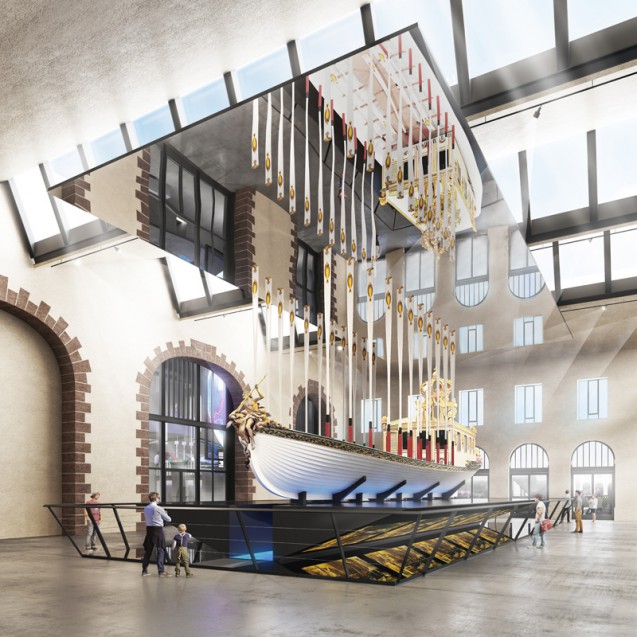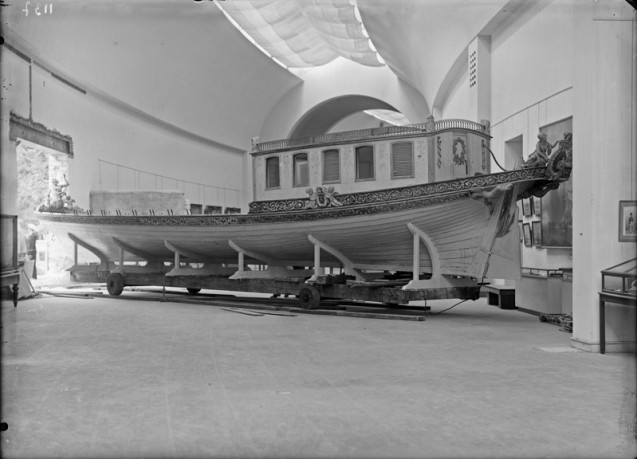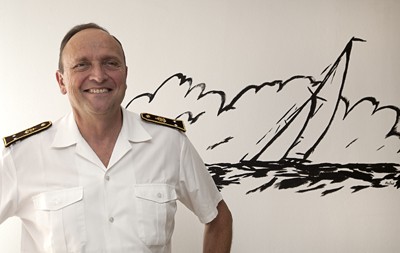On 31 March 2017, the Paris museum closed for extensive renovations. The aim is to reinvent the Musée de la Marine and transform it into a major 21st-century French maritime museum. One of the main objectives of this vast project is to familiarise the general public with the maritime aspect of France. This means giving the public a taste for the sea and an awareness of the issues and challenges that affect maritime matters in every aspect: whether historical, geographical, economic, environmental, scientific or cultural. The future museum will offer a voyage of discovery through specially redesigned spaces, giving new meaning to our maritime heritage.
Among the 890 works that were exhibited in the museum in Paris, the Emperor’s Barge occupies a special place. It is the only ceremonial barge kept in a museum in France, and it is remarkable not only for its size but also for its history. In October 2018, the Barge returned to the city of Brest, on the westernmost tip of Brittany, 75 years after its transfer to Paris.
The Barge will be on show at the “Ateliers des Capucins” media and culture centre in Brest, and the aim is to symbolise subtly the extremely strong link that exists between the Brest Musée de la Marine and the city itself, a city which was recently awarded the French cultural label of “Ville d’art et d’histoire” (City of Art and History). The museum is thus extending its presence in this city, in a place emblematic of maritime history. In 2017, the Brest site of the Musée de la Marine was the second most-visited museum in the Finistère region attracting nearly 75,000 visitors. The museum works closely with entities from the town and surrounding region, as well as with local schools. The Musée de la Marine and the Lycée Dupuy de Lôme were notably awarded the “Prix de l’audace artistique et culturelle” (Prize for artistic and cultural audacity) in the summer of 2018.

The Barge is currently protected and stored in a temporary area in the Ateliers des Capucins. It will be fully restored before being definitively installed in the “Place des Machines” opposite the entrance to the future “Pôle des Excellences Maritimes”, which is due to open in late 2019. The purpose of this “Pôle” is to showcase all of Brest’s maritime expertise in the industrial, ecological, and oceanological fields, etc., in a purpose-designed space of 1,000 m2 on three levels.
Visitors walking in the “Place des Machines”, an area open to all free of charge, will get an excellent view of the Emperor’s Barge from all angles. In the lower part of the display, visitors will have access to dynamic information panels about the origins and history of the Barge. Mirrors placed above the hull reflecting the inside will provide visitors with an additional and original perspective on the Imperial Barge.
Let’s take a look at the history of the Emperor’s Barge. Its construction was decided in the greatest secrecy in the spring of 1810, when the Emperor Napoleon I made plans to go to Antwerp to visit the arsenal, which he had ordered to be built a few years earlier. The engineer Guillemard provided the plans for the Barge, while the master ship builder Théau, a native of Granville, supervised its construction. The realisation of the decorative elements was entrusted to the Antwerp sculptor Van Petersen. After only 21 days, the boat was ready to be launched. It was more than 18 metres long: the rear third was dominated by a spacious deckhouse to accommodate prominent guests, while the rowers occupied the rest of the space, the decoration of which was, at that time, rather rudimentary.
On 30 April 1810, the ceremonial barge made an impressive entry into Antwerp: Napoleon and the young Empress Marie-Louise were on board, accompanied by Marshal Berthier, the Decrès (Minister of the Navy) and Admiral Missiessy (Commander of the Scheldt Squadron) surrounded by a veritable naval cortège. Over several days, the barge was responsible for carrying the Emperor and his guests on the tour of the arsenal: visiting the flagship Le Charlemagne, attending the spectacular launch of Friedland and inspecting the entire fleet.
When the Empire fell, in 1814, the barge was moored in the military port of Brest. Additions were made to its decorative scheme but it remained sober, with an eagle at the prow. Later, it underwent further changes to its decoration before the visit of Napoleon III and Empress Eugenie to Brest in 1858. The sculptural elements that we can see today date from this period, in particular the figurehead representing Neptune, the group of figures at the rear bearing the Imperial arms and, surmounting the deckhouse, a large crown supported by four cherubs. Even the oars were embellished with sumptuous painted motifs.
Thereafter the Emperor’s barge was all but forgotten, indeed it narrowly missed becoming yet another victim of the bombs that destroyed Brest at the end of the Second World War. However, fate would have it that at that time the Musée de la Marine was being set up at the Palais de Chaillot. Since space was no object, it was decided that the Imperial vessel would be its flagship.
The Barge left Brest on 9 May 1943, escorted by the German authorities. The journey to Paris by train took eight days: the railway tracks between Brest station and the Gare Montparnasse were deserted, deliberately, in order that this exceptional convoy would not encounter any other trains. The transfer across Paris by truck was a real spectacle for onlookers.

The whole operation was controlled, measured and timed – with one exception: at its destination, the Palais de Chaillot, a crucial detail had been over-looked – the doors were too narrow for the vessel to pass through! More than two years of negotiations would be required to find a solution. In August 1945, an enormous breach was made in the wall of the Palais de Chaillot and, very slowly, the Imperial barge, which had been left waiting in the Trocadero Gardens, finally entered its sepulchre.
The last restoration of the barge was carried out between 2001 and 2003; the ship cradles and internal structure of the hull were worked on by carpenters from the Cherbourg military workshop, whilst the sculptures, polychromy and gold-work were restored by a group of specific restorers with the financial support of the Fondation Napoléon.
Vincent Campredon, October 2018 (Translation PW and RY)
Commissioner General Vincent Campredon is the Director of the Musée National de la Marine.
De Paris à Brest, le canot de l’Empereur rejoint son port d’attache [From Paris to Brest, the Emperor’s Canoe returns to its home port]: read the press dossier (in French) of the Musée National de la Marine.


